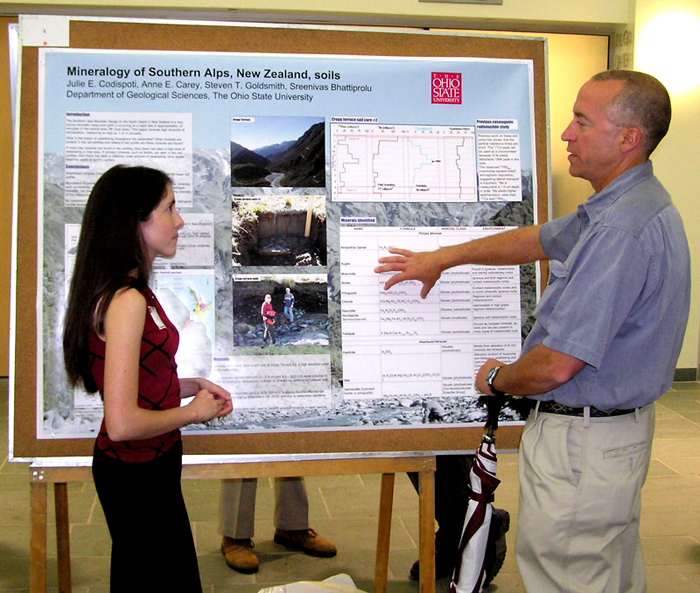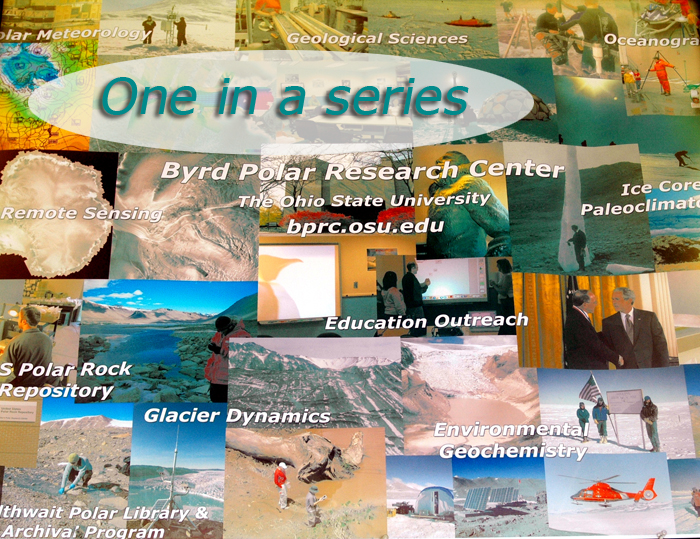
Photo Credit: BPRC Web site |
Julie Codispoti, left, presents her research to Larry Krissek during a forum. Codispoti currently serves as assistant curator at the National Polar Rock Repository at Byrd Polar Research Center. Krissek is an associate professor of earth sciences and a researcher at Byrd Polar. |
Loyalty, longevity hallmarks of those affiliated with research center
The center boasts eight research groups now, including polar meteorology, ice core paleoclimatology, oceanography, glacier dynamics, geology, the polar rock repository, environmental geochemistry and remote sensing.
“We have faculty, staff and students from three different colleges in the university, so we’re very interdisciplinary,” Lyons notes. “We’ve been around for a long time, and to do that we’ve had to be successful. We’ve had a lot of really talented scientists, students, post-docs and staff people over the last 48 years that have made this place what it is.”
Among the big fish swimming in that pool of talent are Lonnie Thompson and Ellen Mosley-Thompson, colleagues and spouses, who developed the ice core paleoclimate team in the 1970s.
If science had superstars like the NFL, the Thompsons would qualify. In February, the duo received the Dan David Prize, a $1 million award given annually by Tel Aviv University in Israel to each of three recipients for achievements having an outstanding scientific, technological, cultural or social impact in the world. They’ve been featured in books, and Lonnie Thompson’s high-altitude exploits to recover ice cores from some of the world’s most inhospitable places have even landed him in pop culture magazine “Rolling Stone.”
Yet the Thompsons have remained at Byrd Polar for most of its existence and their entire careers. Other offers have likely come their way, but they see no reason to leave.
“We have not found anything that we wanted to do that we couldn’t do out of Ohio State. There’s never a need to go somewhere else, because we’ve always been able to do what we wanted to do from this platform,” says Mosley-Thompson, a university distinguished scholar in the Department of Geography.
“We’re rewarding their loyalty to us with our loyalty to the institution,” she adds.
Her academic roots at OSU run deep: One of Mosley-Thompson’s mentors was Goldthwait, BPRC’s first director. “I have these links back to the founding fathers of the institution. I have always felt very well supported by the institution,” she says. “I think timing is really important. I think we were here at a critical time when polar research was of a broad interest.”
Longevity, as well as loyalty, seems a hallmark at BPRC. Terry Wilson, a professor in the School of Earth Sciences, came to OSU in 1985, though she was not originally drawn to the university to do polar science. Her groundbreaking work in Antarctica studying crustal deformation and other geological processes might not have happened without the presence of BPRC.
A first trip to Antarctica can be intimidating logistically, Wilson explains, so she was happy to have a wealth of experience at hand. “I could go right down the hall and ask person A, B and C if they had aerial photographs or maps,” says Wilson, who has made 15 trips to the Ice. “All of these resources made it possible for me to get started, and it would have been a much greater barrier for a first-time person to put that together.”
Ken Jezek had already been to Antarctica a number of times before coming to BPRC in 1989 to serve as its fifth director, a position he held for 10 years. He still works at the research center, heading its remote sensing group, which uses radar and satellites to study ice sheet dynamics.
“It’s very satisfying,” he says of the near 20-year relationship with Byrd Polar. “I think the best part of it is that when you look around and see all of the top scientists in this field, and realize how many of them have been affiliated in one way or another … with the Byrd center, [that] has been a great deal of satisfaction.”
Some 75 people are affiliated with the BPRC in one way or another. About a third are graduate students, and as many as 20 people are investigators engaged in research thanks to grants from the National Science Foundation, NASA or NOAA, according to Lyons.
“We have people in the field all of the time. It’s not a huge operation by any stretch, but it is a dynamic and active one,” he says.
With the various problems and challenges posed by climate change, it seems that operation will only grow. “The work here has become even more relevant to society,” Lyons agrees. “We’re at the forefront of understanding how the cryosphere, the ice of the planet, is responding to the climate.”
Back 1 2






